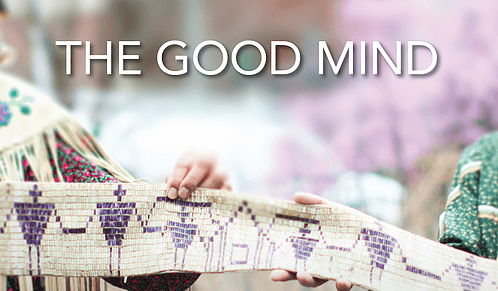Imagine a world where caring for each other, our environment, and ourselves comes naturally. This interconnected harmony is the essence of “The Good Mind,” a core principle within Haudenosaunee philosophy that has shaped their governance, culture, and commitment to social justice for centuries.
Planting Seeds of Kindness: Understanding the Haudenosaunee Good Mind
The Haudenosaunee, also known as the Iroquois Confederacy, have a unique way of thinking known as the “Good Mind.” Imagine your thoughts as seeds: plant good seeds, and you cultivate a beautiful garden. Similarly, the Good Mind centers on planting positive, kind, and compassionate thoughts, believing they have a tangible impact on the world.
This isn’t about denying negative emotions or pretending everything is perfect. It’s about acknowledging those thoughts and consciously choosing kindness instead. This continuous practice of “weeding out” negativity to make space for compassion forms the foundation of the Good Mind.
But it goes beyond individual well-being. The Haudenosaunee have a deep spiritual connection to the Creator and believe in seeking guidance to live in harmony with the world. It’s about recognizing our interconnectedness and the ripple effects of our actions, extending kindness and respect to all beings – human, animal, plant, and the Earth itself.
This centuries-old wisdom aligns with the modern emphasis on mindfulness and social justice. The Good Mind encourages us to be present with our thoughts and to consider the well-being of all, reflecting a timeless blueprint for inner peace and a better world.
Cultivating Harmony: Key Teachings of the Haudenosaunee
The Haudenosaunee Good Mind is not merely a philosophy; it’s a way of life. It suggests that by striving for harmony—a state of balance and well-being known as Skä·noñh— in all aspects of life, we can cultivate a better world. Let’s explore the core teachings that breathe life into this powerful concept:
- Mindfulness: Like hitting the pause button on a hectic day, mindfulness involves paying attention to our thoughts and feelings without judgment. It’s about acknowledging our inner landscape without getting swept away by it.
- Gratitude: Taking time to appreciate the good in our lives, big or small, is key to cultivating the Good Mind. Focusing on the positive helps release negativity and fosters a sense of contentment.
- Respect: This seemingly simple principle—treating others how we want to be treated—forms the bedrock of a harmonious society. It’s about recognizing the inherent worth of every individual, regardless of differences.
- Responsibility: The Good Mind emphasizes understanding the impact of our actions on the world around us. It’s about recognizing our responsibility to future generations and the Earth itself.
- Peacemaking: Conflict is inevitable, but how we choose to approach it makes all the difference. The Good Mind encourages peaceful solutions, prioritizing dialogue and understanding over aggression.
These teachings are not theoretical; they have been woven into the fabric of Haudenosaunee life for centuries. They serve as a powerful reminder that a better world is possible, starting with cultivating the Good Mind within each of us.
Ka’nikonhriyo: The Good Mind in Mohawk
The Mohawk language has a specific word for the Good Mind: Ka’nikonhriyo. This term goes beyond simple positivity; it embodies a personal and communal promise to live righteously. It’s about aligning one’s thoughts and actions with the Haudenosaunee principles of peace and balance, consistently striving to make choices that benefit all.
Rooted in the Haudenosaunee creation story, Ka’nikonhriyo represents the active pursuit of spiritual strength, known as Orenda, through actions that benefit the community and uphold the Great Law of Peace. Achieving this state isn’t about perfection but about consistently choosing a better path.
The Haudenosaunee believe that everyone possesses the potential for both good and bad within. Even those who’ve strayed from the path of the Good Mind can find their way back. It’s never too late to embrace Ka’nikonhriyo and experience its transformative power.
This timeless wisdom resonates with modern movements for social justice, environmental protection, and personal growth. The Good Mind’s message transcends cultural boundaries, offering a path towards a more harmonious and fulfilling life for all.
The Haudenosaunee Theory: Shaping Reality Through the Good Mind
Beyond a political structure, the Haudenosaunee theory offers a unique perspective on life, emphasizing self-governance through the “Good Mind.” It suggests that our thoughts are incredibly powerful, acting as seeds that shape the reality we experience.
This theory, sometimes referred to as the “Good Mind” itself, emphasizes that when we nurture positive and peaceful thoughts, we cultivate a world aligned with those values. It recognizes the interconnectedness of all things, proposing that we are part of a larger web of life where even small actions can have a ripple effect, influencing those around us in both positive and negative ways.
Central to this theory is living in sync with nature. The Haudenosaunee view themselves as caretakers of the Earth, responsible for protecting its delicate balance. This commitment to sustainability ensures that future generations inherit a healthy and thriving planet.
It’s important to note that the Haudenosaunee theory is a complex concept with ongoing study and varying interpretations. While some experts believe it offers profound insight into personal and societal well-being, exploring diverse perspectives can deepen our understanding of its potential.
The Fabric of Life: Uncovering Haudenosaunee Spiritual Beliefs
The Haudenosaunee have a deeply rooted spiritual tradition that underpins their entire way of life. Central to this tradition is the concept of the “Good Mind,” a guiding force encouraging good thoughts, deeds, and respect for all living things.
For the Haudenosaunee, the Good Mind is not merely a belief; it’s an active, daily practice. It’s about making conscious choices to be kind, compassionate, and respectful, tapping into the powerful energy known as Orenda – the spiritual life force that flows through all beings.
This emphasis on actively cultivating the Good Mind manifests in various ways:
- The Great Law of Peace: This constitution, woven into their spiritual beliefs, mandates that all decisions be made through consensus, ensuring every voice is heard and fostering unity.
- The Thanksgiving Address: This beautiful ritual involves expressing gratitude for all elements of creation, from the trees and animals to the water and air. It’s a powerful reminder of our interconnectedness and the importance of respecting every aspect of the natural world.
- Reverence for Nature: The Haudenosaunee view themselves as caretakers of the Earth, responsible for maintaining its delicate balance. This deep respect for nature permeates their ceremonies, rituals, and daily lives.
- Belief in the Afterlife: The Haudenosaunee believe in a reckoning after death, where those who have lived by the Good Mind find peace, while those who chose a different path might face consequences. This belief reinforces the importance of living responsibly and making amends for wrongdoings in the present.
The Haudenosaunee’s spiritual beliefs emphasize peace, gratitude, and respect for the environment, values that resonate deeply in the modern world. Their ancient wisdom offers guidance for navigating contemporary challenges and creating a more harmonious future.
Interested in exploring diverse leadership styles? Discover how Machiavelli’s “The Prince” contrasts with the Haudenosaunee approach to power. For a historical perspective, delve into the reigns of influential figures like Henry of Bolingbroke, Gustavus Adolphus, and Rutherford B. Hayes. Their legacies offer valuable insights into the complexities of leadership and its impact on society.















